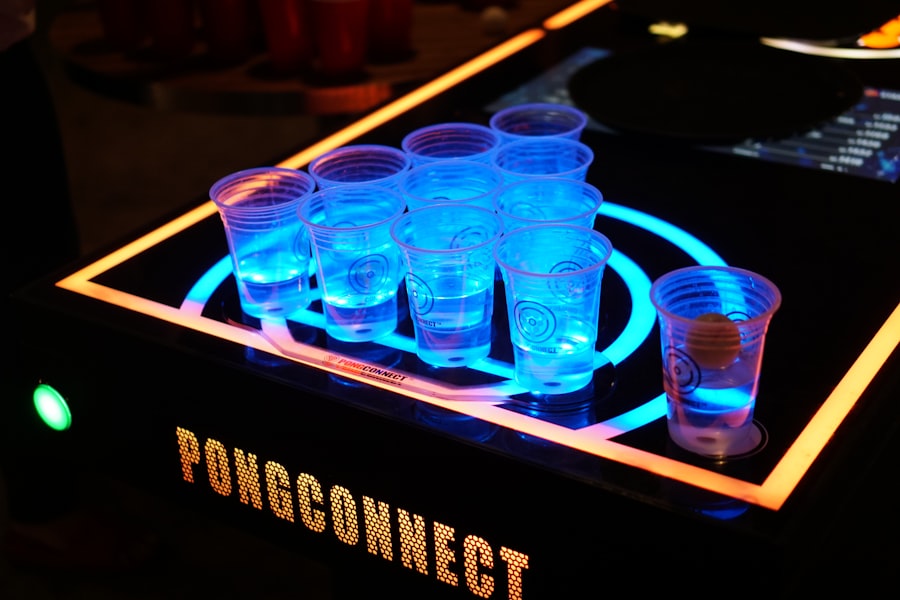Download links
How to install The Ultimate Guide to Mastering Table Tennis APK?
1. Tap the downloaded The Ultimate Guide to Mastering Table Tennis APK file.
2. Touch install.
3. Follow the steps on the screen.
Description
Table tennis, often referred to as ping pong, is a fast-paced sport that combines agility, precision, and strategic thinking. Originating in England during the late 19th century as a parlor game, it has evolved into a highly competitive sport played worldwide. The game is played on a rectangular table divided by a net, with players using small paddles to hit a lightweight ball back and forth.
The objective is to score points by making the ball land on the opponent’s side of the table in such a way that they cannot return it. Understanding the basic rules and structure of the game is essential for anyone looking to engage in table tennis, whether casually or competitively. The game can be played in singles or doubles formats, with each player or team aiming to reach 11 points first, winning by at least a two-point margin.
Players serve the ball from behind their end of the table, and the serve must bounce once on their side before crossing the net. The ball must then bounce on the opponent’s side before they can return it. Scoring can occur when an opponent fails to return the ball correctly or when they hit it out of bounds.
Familiarity with these fundamental rules lays the groundwork for developing more advanced skills and strategies as players progress in their table tennis journey.
Key Takeaways
- Table tennis is a fast-paced game that requires quick reflexes and precise hand-eye coordination.
- Mastering the fundamentals of table tennis techniques, such as grip, stance, and stroke mechanics, is essential for success in the game.
- Developing effective serving strategies can give players a competitive edge and control over the game.
- Improving footwork and movement on the table is crucial for reaching and returning shots effectively.
- Enhancing hand-eye coordination and reflexes through drills and practice can greatly improve a player’s performance on the table.
Mastering the Fundamentals of Table Tennis Techniques
To excel in table tennis, mastering fundamental techniques is crucial. The grip is one of the first aspects players should focus on, as it directly influences control and power. The two most common grips are the shakehand grip and the penhold grip.
The shakehand grip resembles a handshake and allows for versatile strokes, while the penhold grip, which involves holding the paddle like a pen, offers unique advantages in terms of wrist flexibility and spin generation. Players should experiment with both grips to determine which feels more comfortable and effective for their style of play. In addition to grip, players must develop their strokes, including forehand and backhand drives, pushes, and loops.
The forehand drive is typically executed with a forward motion of the arm while maintaining a stable wrist, allowing for powerful shots that can penetrate an opponent’s defense. Conversely, the backhand drive requires a different technique, often involving a sideways motion of the body to generate speed and accuracy. Mastering these strokes involves not only practicing the mechanics but also understanding when to use each stroke effectively during a match.
Consistent practice will help players develop muscle memory, enabling them to execute these techniques instinctively under pressure.
Developing Effective Serving Strategies

Serving is one of the most critical aspects of table tennis, as it sets the tone for each rally. A well-executed serve can give players a significant advantage by putting their opponents on the defensive right from the start. There are various types of serves that players can employ, including topspin serves, backspin serves, and side-spin serves.
Each type has its own unique characteristics and can be used strategically to exploit an opponent’s weaknesses. For instance, a topspin serve can be particularly effective against players who struggle with high-bouncing balls, while a backspin serve can cause confusion for those who find it challenging to read spin. Additionally, varying the placement of serves—targeting different areas of the opponent’s side—can disrupt their rhythm and force them into making errors.
Players should practice serving with different spins and placements to develop a repertoire that keeps opponents guessing and unable to anticipate their next move.
Improving Footwork and Movement on the Table
| Metrics | Target | Current |
|---|---|---|
| Number of footwork drills practiced per week | 5 | 3 |
| Accuracy of footwork movements | 90% | 85% |
| Speed of lateral movements | 0.5 seconds | 0.7 seconds |
| Endurance during extended rallies | 30 minutes | 25 minutes |
Footwork is an often-overlooked aspect of table tennis that plays a vital role in a player’s overall performance. Quick and agile footwork allows players to position themselves optimally for each shot, ensuring they can respond effectively to their opponent’s plays. Developing good footwork involves practicing lateral movements, quick pivots, and efficient positioning around the table.
Players should focus on maintaining a low center of gravity and using small steps to adjust their position rather than large strides that can lead to loss of balance. Incorporating footwork drills into training sessions can significantly enhance movement skills. For example, players can practice shadowing their strokes without a ball, emphasizing proper foot placement and body alignment.
Additionally, drills that involve moving to specific spots on the table in response to simulated shots can help players develop their reaction times and improve their overall agility. By prioritizing footwork training, players can enhance their ability to reach difficult shots and maintain control during fast-paced exchanges.
Enhancing Hand-Eye Coordination and Reflexes
Hand-eye coordination is crucial in table tennis due to the rapid pace at which the game is played. Players must be able to track the ball’s trajectory while simultaneously preparing their bodies to execute precise shots. To enhance hand-eye coordination, players can engage in various drills that focus on tracking moving objects.
For instance, practicing with a partner who tosses balls at different speeds and angles can help players improve their ability to judge distance and timing. Reflexes are equally important in table tennis, as players often have mere fractions of a second to react to an opponent’s shot. To sharpen reflexes, players can utilize reaction training tools such as reaction balls or even simple wall drills where they hit a ball against a wall and react to its unpredictable rebounds.
Incorporating these exercises into regular training routines will not only improve hand-eye coordination but also enhance overall responsiveness during matches.
Perfecting Spin and Control Techniques

Understanding Spin Techniques
Mastering spin techniques is essential in table tennis, as it allows players to manipulate the ball’s trajectory and bounce, making it more challenging for opponents to return shots effectively. There are several types of spin that players can utilize: topspin, backspin, and sidespin are among the most common.
For topspin shots, players need to brush up against the ball while maintaining an upward motion; this creates forward rotation that causes the ball to dip quickly after crossing the net.
Mastering Different Spin Types
Conversely, backspin shots require a downward brushing motion that causes the ball to float low over the net before spinning back towards the player’s side. Practicing these techniques consistently will enable players to gain better control over their shots while also making it difficult for opponents to predict their next move.
Strategies for Playing Singles and Doubles Matches
The dynamics of singles and doubles matches in table tennis differ significantly, requiring players to adapt their strategies accordingly. In singles play, each player has full control over the entire table area, allowing for more aggressive tactics such as attacking with powerful shots or employing strategic placement to exploit weaknesses in an opponent’s defense. Players should focus on maintaining consistent pressure through aggressive serves and quick transitions between offense and defense.
In doubles matches, communication and teamwork become paramount. Players must develop an understanding of each other’s strengths and weaknesses while coordinating their movements effectively around the table. Strategies such as alternating serves or positioning themselves strategically based on their partner’s shot can create opportunities for scoring points.
Additionally, players should be aware of their opponents’ positioning and adjust their tactics accordingly; for example, targeting weaker players or exploiting gaps in coverage can lead to successful rallies.
Mental and Physical Conditioning for Table Tennis Success
Success in table tennis extends beyond technical skills; mental resilience and physical conditioning are equally important components of a player’s performance. Mental conditioning involves developing focus, concentration, and confidence during matches. Techniques such as visualization—where players mentally rehearse successful plays—can enhance performance under pressure by reinforcing positive outcomes in their minds.
Physical conditioning is also essential for sustaining energy levels throughout matches. Table tennis requires quick bursts of speed combined with endurance; therefore, incorporating cardiovascular training alongside strength exercises can improve overall fitness levels. Plyometric exercises that enhance explosive power are particularly beneficial for improving quick movements around the table.
By prioritizing both mental and physical conditioning, players can ensure they are well-prepared for competitive play while maximizing their potential on the table. In conclusion, mastering table tennis requires dedication across multiple dimensions—from understanding basic rules to refining advanced techniques and strategies. By focusing on each aspect systematically, players can develop into well-rounded competitors capable of excelling in both casual games and high-stakes tournaments alike.
FAQs
What is table tennis?
Table tennis, also known as ping-pong, is a sport in which two or four players hit a lightweight ball back and forth across a table using small bats.
What are the basic rules of table tennis?
The basic rules of table tennis include serving the ball diagonally across the table, allowing the ball to bounce once on each side of the net, and scoring points when the opponent fails to return the ball.
What equipment is needed to play table tennis?
To play table tennis, you need a table tennis table, table tennis bats (also known as paddles or rackets), table tennis balls, and a net.
What are the health benefits of playing table tennis?
Playing table tennis can improve hand-eye coordination, reflexes, and balance. It also provides a good cardiovascular workout and can help to improve mental acuity.
What are the different types of table tennis shots?
The different types of table tennis shots include the forehand drive, backhand drive, topspin, backspin, and smash. Each shot has its own technique and purpose in the game.
What is the history of table tennis?
Table tennis originated in England in the late 19th century as an indoor version of lawn tennis. It has since become a popular sport worldwide and is an Olympic event.





